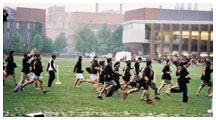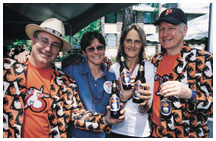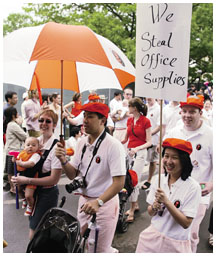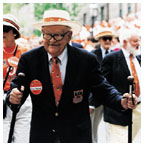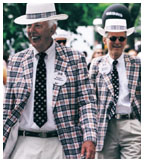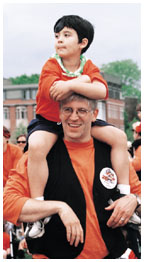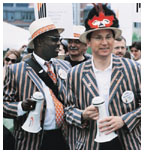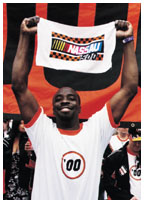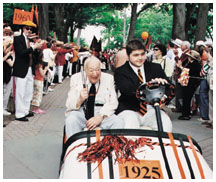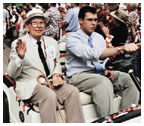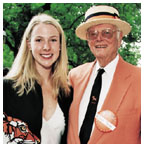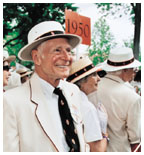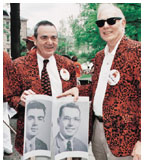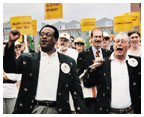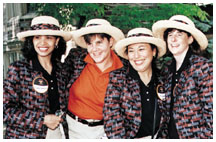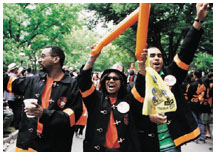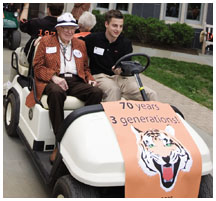Have an opinion about this issue of PAW? Please take a minute to click here and fill out our online survey. It’s an easy way to let the editors know what you like and dislike, and how you think PAW might do better. (All responses will be anonymous.) |
July 6, 2005: Features
2005 Reunions
Photographs by Beverly Schaefer and Frank Wojciechowski
The Class of 2005 in its P-rade sprint across Poe Field.
Awaiting its turn, the Class of 2005 cheers on P-raders from the sidelines.
Toasting their 30th with Tiger Beer are, from left, John Mesrobian ’75; his partner, Cyndy Becker; Gail Baumbach s’75, and Bill Baumbach ’75 *87. The class brought the beer, from Singapore, to Reunions.
The Class of 1995, sporting golf umbrellas, shirts, and hats, returned to “play the back ’95.” The umbrellas would come in handy later.
Barney Barnhart ’45 has a big smile and a quick stride as he makes his way down the P-rade route during his 60th reunion.
Fifty years after graduation, ’55ers Gene Herbert, left, and Stuart Raynor Jr. march through campus again.
Ready for the “P-rates of the Caribbean” pirate adventure are 20th-reuner Richard Dzina ’85 and his son, Buddy.
Graduate alumni Darryl Peterkin *95 and Dan Abramowicz *84 lead the APGA delegation in its Mardi Gras theme, with many reuners wearing feathered masks and throwing beads to the crowd.
For his fifth, Paul Rodney heads to the P-rade finish in the Class of 2000’s Nassau 500.
For the fourth consecutive year, Leonard Ernst ’25, who turned 100 in March, carries the Class of 1923 silver cane, which is awarded to the oldest returning alumnus. Ernst, driven by Brandon Bierlein ’08, leads the Old Guard.
Class of 1930 President and Secretary Jack Myers Jr. draws cheers as the Old Guard makes its way through campus. He is driven by David Light ’07.
Edwin Seipp ’40 poses with his grandniece, Carolyn Goltra ’03.
Bob Baird ’50 flashes his 55th-reunion smile.
Time has treated them well: Armand Derfner ’60, left, and Don Kramer ’60, with their 45-year-old Nassau Herald photos.
Chris Gores ’65 and his wife, Julie, comment on differences between their college days and today.
Steve Dawson, left, and Marc Weisburd pump up the Class of 1970’s 35th “buggy” procession.
Sporting new Class of 1980 25th-reunion jackets are, from left, Norma Santamaria, Eve LaPlante, Sylvia Hurtado, and Elaine Soffer.
“Still hot at 15” are ’90ers, from left, Clem Turner, Sheila Boston, and David Malebranche. The class P-raded with a working fire truck that reuners used to spray onlookers with water.
Spanning three generations are Frank Cheston ’35 and Timothy Cheston ’08. At least 20 classmates and family members returned for the Class of 1935’s 70th reunion. (Jon Roemer)
|
The heavens were no match for the Class of 2005. By the time the class was passing under the arch at the new Bloomberg Hall dorm and entering Poe Field as the P-rade neared its end, a gathering storm was just letting loose. Public Safety officers warned participants to take cover from the rain and lightning, but the seniors paid no heed. Drenched but happy, they roared past the nearly empty reviewing stands.
As Derek Jun ’05 explained it: Reunions makes Princeton seem even larger than what he experienced as a student.
Almost 20,000 alumni, family, and friends returned to Princeton for Reunions weekend, May 26 through 29. As it does every year, the weekend provided a time to renew old friendships, make new ones, and reminisce about college life. It’s about “reconnections,” said Shelley deButts ’80. Twenty-five years out, she said, there is “no more peacocking” — classmates comparing jobs and prestige. Instead, she said, people want to share in each other’s lives and families.
Enthusiasm like that displayed by the Class of 2005 was not limited to the young. At the Old Guard luncheon on Saturday, Leonard Ernst ’25, who turned 100 on March 2, won the silver cane, awarded to the oldest returning alumnus, for the fourth year in a row. The only other member of the Class of 1925 to attend Reunions, Malcolm Warnock, whose 100th birthday was June 21, received a book on Princeton history from President Tilghman. The Class of 1935 made a strong showing, with 14 classmates plus family members.
Along the P-rade route, participants and spectators rewarded the marchers with locomotives and applause, cheering the placards that joked about everything from age (’65’s “Then Rolling Stones, Now Kidney Stones”) to jobs (’80’s “82% are not lawyers”), to Reunions costumes (’95’s “I don’t usually dress like this”). Joseph “Jody” Robinson ’65 showed off his agility riding a skateboard through the P-rade. Graduate alumni, sporting a Mardi Gras theme, wore orange and black feathery masks and threw out plastic beads and chocolate coins to children on the route. Waiting to step out, Benjamin Jones ’95 rocked his sleeping 3-month-old daughter as his wife, Juliet Sorensen ’95, reveled in the moment. The couple met at Princeton and had traveled from Chicago for Reunions. Whether or not to attend their 10th “wasn’t even a question,” Sorensen said.
Revelry was mixed with reflection. Reuners flocked to alumni-faculty forums; in total, about 2,300 people attended 14 panel discussions on Friday and Saturday. “Crossroads of Policy: Iraq, Afghanistan, and the Middle East,” moderated by L. Carl Brown, a Princeton professor of Near Eastern studies and foreign affairs, emeritus, was the most popular with 400 in attendance at McCosh 50. Alumni packed into Robertson Hall to listen to alumni journalists discuss whether mainstream media can survive the challenges posed by bloggers, public criticism, and attacks from both the left and right. Alumni heard Dean of Admission Janet L. Rapelye talk about the college admission process; members of the classes of ’55, ’80, and ’05 compare their Princeton experiences; and President Tilghman answer questions at her annual “conversation with alumni.” Although not part of the official Reunions schedule, consumer advocate and third-party presidential candidate Ralph Nader ’55 spoke at the Nassau Presbyterian Church on a range of political and social justice issues, sharing the stage with rocker Patti Smith and guitarist Lenny Kaye.
Other activities were just plain fun. An alumni golf tournament began with a “shotgun start” at 8 a.m. Friday; early risers the next day joined in a three-mile “fun run.” Kids were the focus of the Saturday morning Children’s Asian Culture Festival in McCosh Courtyard that featured origami, kimono dressing, storytelling, and fan and folk dances. Other events included a poetry reading sponsored by the Nassau Literary Review, a well-attended tree tour of the campus led by Philo Elmer ’69, and the 1960s-style folk singing of Ed Labowitz ’70 and his acoustic folk trio. Listeners in the packed Café Vivian in the Frist Campus Center sipped smoothies and clapped along.
On cue, Saturday’s storm moved out in time for the traditional Reunions conclusion: an evening lawn concert by the Princeton University Orchestra, fireworks on Finney Field, and class parties that lasted into the morning.
Perhaps Rocio Rosales ’05 best summed up the power of the Reunions
experience. A Mexican-American, Rosales said that until Reunions weekend
she had felt like an outsider at Princeton. But seeing so many alumni
from diverse cultural backgrounds come back to share their connection
to Princeton convinced Rosales that she, too, is linked to all alumni.
“This is the first time you realize that you are a part of something
bigger than your class,” she said. ![]()
By K.F.G.
Music
to march by
John Philip Sousa’s band rarely paraded
– but it did for Princeton
By Mark F. Bernstein ’83
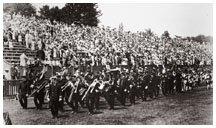
Pictured: John Philip Sousa and his band enter University Field for the 25th reunion of John Philip Sousa Jr. in 1929. It was one of the few times when the Sousa band, known for its marching music, actually marched. (Princeton University Archives)
Over the decades, the P-rade has been graced by all manner of musical entertainment, from string bands to calliopes. But perhaps never has it seen as big a headliner as in 1929, when the Class of 1904 kicked off its 25th reunion led by the world-famous John Philip Sousa band, with the great composer himself, in full uniform, at the head.
John Philip Sousa was the most famous musician in the world at that time — the New York Times once declared him more recognizable than the president of the United States – and internationally renowned for his martial marches. His was the “first musical act to travel more than a million miles and perform for more than a million people,” according to one Sousa Web site (www.dws.org/sousa/band.htm).
Sousa called himself a “salesman for Americanism,” providing the sound track, as it were, for America’s rise to world power, and he had been at the peak of his popularity during those heady days of Theodore Roosevelt and the Big Stick when the Class of 1904 had graduated. He was also a first-rate musician and the author of several hit operettas. “Sousa was to the march,” writes historian Ernest B. Ferguson, “what Beethoven and Mozart were to classical music.”
Though renowned for marches such as “The Washington Post March” and, most famously, “Stars and Stripes Forever,” the Sousa band was not a marching band. “His band was comparable to, and in many cases more accomplished than, the symphony orchestras of the day,” explains Tom Spain, a documentary filmmaker and Sousa buff. “He didn’t want to be thought of as street entertainment. He was concert-hall entertainment.” During the 39 years that Sousa led the band, it played thousands of concerts, but marched only half a dozen or so times. One of those times was at the Class of 1904’s 25th.
The band marched that day because Sousa’s son, John Philip Sousa Jr., was a member of the 25th-reunion class. From what little can be gleaned about him, Jack Sousa, as he was known, had an unremarkable career at Princeton and afterwards, working for an automobile company before starting his own manufacturing firm. According to his son, John Philip Sousa III ’36, his real passions were hunting, fishing, golf, and tennis. “My father was a large and amiable man,” Sousa III wrote in a memoir titled My Family Right or Wrong, “...but he had particular difficulty with small boys and often threatened to ‘put a bullet into a couple of them.’ Since he had such a large collection of guns, he naturally visualized all warfare from the shooter’s angle.”
How Sousa Jr. persuaded his father’s band to march in the P-rade is a mystery, though Loras Schissel, a musicologist at the Library of Congress, says we can speculate pretty well. “I imagine Sousa Jr. asked Pop how much it would cost to contract the band for a one-day event,” Schissel says. “I’m sure the class paid for it. The musicians who played for Sousa were New York- and Philadelphia-area players who could meet in Princeton for the event.”
Spain adds that by 1929, “Sousa’s band was a bit on the wane. But it would have a great deal of appeal to members of the reunion classes because of the band’s huge popularity from 1892 up through World War I.” Though there is no real comparison to Sousa today, one might imagine a similar stir if the Class of 1980 had hired Bruce Springsteen and the E Street Band to lead them in this year’s P-rade.
But the P-rade is not just any appearance, and even the Sousa band had to accommodate itself to Princeton tradition — including having to share space in ’04’s ranks with a bagpipe band hired to complement the class’s Scottish costumes. What the Sousa band played as it marched is unrecorded, although again, one can speculate. In addition to some Princeton fight songs, Spain says, there also would have been something light, in keeping with the spirit of the event. (Spain notes that Sousa wrote his own arrangements for popular Gershwin tunes as well as for the Tin Pan Alley favorite, “Has Anybody Here Seen Kelly?”) Leading the way down to University Field, site of the Princeton-Yale baseball game and for decades the P-rade’s terminus, the band just made it before the June skies opened up.
More in keeping with its practice, the band gave a concert that evening at the class’ headquarters (located off-campus, possibly to accommodate drinking during Prohibition, and decorated to look like a Scottish village). A program for that event does survive. Selections included “The Last Days of Pompeii,” portions of “Aida,” a xylophone solo, a medley of Scottish songs, and “Old Nassau.” “That concert, of course, was grand,” said an account in PAW, “and the ovations given such old favorites as ‘Stars and Stripes Forever’ beggared all description.” At a class meeting, Sousa unanimously was made an honorary member of the class.
Three years later, Sousa died, and his band died with him. The band’s
P-rade appearance occurred just months before the stock market crash and
the start of the Great Depression, a time when dance music succeeded concert
music, and particularly martial tunes, in popular tastes. The 1929 P-rade
was, in a sense, one of the Sousa band’s last hurrahs. ![]()
Mark F. Bernstein ’83 is PAW’s senior writer.
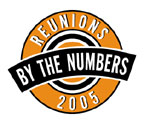
(Graphic by Steven Veach)
Classes in the P-rade: 74, beginning with the Class of 1925
Student workers: about 1,200
Fireworks consumed Saturday night: 2,360 aerial display shells; 9,182 ground effects
On the menu: 4,280 pounds of fruit salad; 1,740 pounds of hamburger; 1,510 pounds of turkey breast; 1,130 pounds of chicken nuggets
Alumni golf tournament entries: 90
Three-Mile Fun Run entries: 50
Number of years the P-rade has been held: 104. The first P-rade in which all reuning classes participated took place in 1897. The tradition was suspended only five times, all during wartime: in 1917, 1918, 1943, 1944, and 1945. Rain forced a cancellation in 1953 but some classes marched anyway.
Downpours: In 1988 it poured on the seniors as they joined the P-rade, just like this year.
More reunions coverage at PAW Online


